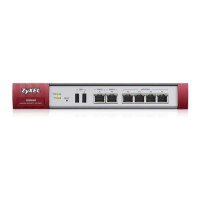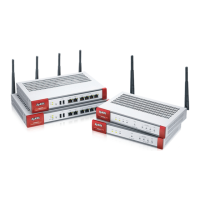Chapter 41 Packet Flow Explore
ZyWALL ATP Series User’s Guide
797
The following table describes the labels in this screen.
Table 356 Maintenance > Packet Flow Explore > Routing Status
LABEL DESCRIPTION
Routing Flow This section shows you the flow of how the Zyxel Device determines where to route a packet.
Click a function box to display the related settings in the Routing Table section.
Routing Table This section shows the corresponding settings according to the function box you click in the
Routing Flow section.
The following fields are available if you click Direct Route, Static-Dynamic Route, or Main Route in the Routing Flow
section.
# This field is a sequential value, and it is not associated with any entry.
Destination This is the destination IP address of a route.
Gateway This is the IP address of the next-hop gateway or the interface through which the traffic is
routed.
Interface
This is the name of an interface associated with the route.
Metric This is the route’s priority among the displayed routes.
Flags This indicates additional information for the route. The possible flags are:
• A - this route is currently activated
• S - this is a static route
• C - this is a direct connected route
• O - this is a dynamic route learned through OSPF
• R - this is a dynamic route learned through RIP
• B - this is a dynamic route learned through BGP
• G - the route is to a gateway (router) in the same network.
• ! - this is a route which forces a route lookup to fail.
• B - this is a route which discards packets.
• L - this is a recursive route.
Persist This is the remaining time of a dynamically learned route. The Zyxel Device removes the route
after this time period is counted down to zero.
The following fields are available if you click Policy Route in the Routing Flow section.
# This field is a sequential value, and it is not associated with any entry.
Incoming This is the interface on which the packets are received.
Source This is the source IP address(es) from which the packets are sent.
Destination This is the destination IP address(es) to which the packets are transmitted.
Service This is the name of the service object. any means all services.
Source Port
This is the source port(s) from which the packets are sent.
DSCP Code
This is the DSCP value of incoming packets to which this policy route applies. See Section 10.2
on page 301 for more information.
Next Hop Type This is the type of the next hop to which packets are directed.
Next Hop Info • This is the main route if the next hop type is Auto.
• This is the interface name and gateway IP address if the next hop type is Interface /GW.
• This is the tunnel name if the next hop type is VPN Tunnel.
• This is the trunk name if the next hop type is Trunk.
The following fields are available if you click 1-1 SNAT in the Routing Flow section.
# This field is a sequential value, and it is not associated with any entry.
NAT Rule This is the name of an activated 1:1 or Many 1:1 NAT rule in the NAT table.
Source This is the external source IP address(es).
Protocol This is the transport layer protocol.
Source Port This is the source port number.

